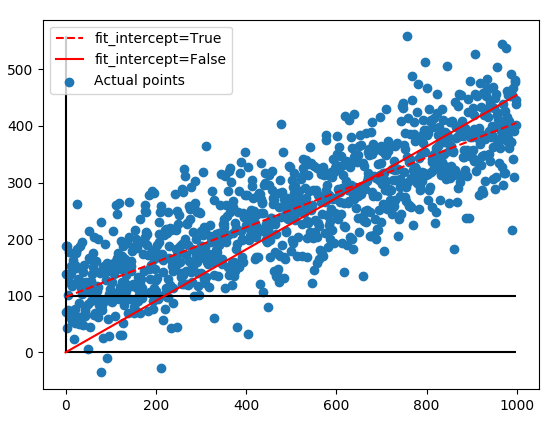fit_intercept=False sets the y-intercept to 0. If fit_intercept=True, the y-intercept will be determined by the line of best fit.
from sklearn.linear_model import LinearRegression
from sklearn.datasets import make_regression
import numpy as np
import matplotlib.pyplot as plt
bias = 100
X = np.arange(1000).reshape(-1,1)
y_true = np.ravel(X.dot(0.3) + bias)
noise = np.random.normal(0, 60, 1000)
y = y_true + noise
lr_fi_true = LinearRegression(fit_intercept=True)
lr_fi_false = LinearRegression(fit_intercept=False)
lr_fi_true.fit(X, y)
lr_fi_false.fit(X, y)
print('Intercept when fit_intercept=True : {:.5f}'.format(lr_fi_true.intercept_))
print('Intercept when fit_intercept=False : {:.5f}'.format(lr_fi_false.intercept_))
lr_fi_true_yhat = np.dot(X, lr_fi_true.coef_) + lr_fi_true.intercept_
lr_fi_false_yhat = np.dot(X, lr_fi_false.coef_) + lr_fi_false.intercept_
plt.scatter(X, y, label='Actual points')
plt.plot(X, lr_fi_true_yhat, 'r--', label='fit_intercept=True')
plt.plot(X, lr_fi_false_yhat, 'r-', label='fit_intercept=False')
plt.legend()
plt.vlines(0, 0, y.max())
plt.hlines(bias, X.min(), X.max())
plt.hlines(0, X.min(), X.max())
plt.show()
This example prints:
Intercept when fit_intercept=True : 100.32210
Intercept when fit_intercept=False : 0.00000
Visually it becomes clear what fit_intercept does. When fit_intercept=True, the line of best fit is allowed to "fit" the y-axis (close to 100 in this example). When fit_intercept=False, the intercept is forced to the origin (0, 0).
![fit_intercept in sklearn]()
What happens if I include a column of ones or zeros and set fit_intercept to True or False?
Below shows an example of how to inspect this.
from sklearn.linear_model import LinearRegression
from sklearn.datasets import make_regression
import numpy as np
import matplotlib.pyplot as plt
np.random.seed(1)
bias = 100
X = np.arange(1000).reshape(-1,1)
y_true = np.ravel(X.dot(0.3) + bias)
noise = np.random.normal(0, 60, 1000)
y = y_true + noise
# with column of ones
X_with_ones = np.hstack((np.ones((X.shape[0], 1)), X))
for b,data in ((True, X), (False, X), (True, X_with_ones), (False, X_with_ones)):
lr = LinearRegression(fit_intercept=b)
lr.fit(data, y)
print(lr.intercept_, lr.coef_)
Take-away:
# fit_intercept=True, no column of zeros or ones
104.156765787 [ 0.29634031]
# fit_intercept=False, no column of zeros or ones
0.0 [ 0.45265361]
# fit_intercept=True, column of zeros or ones
104.156765787 [ 0. 0.29634031]
# fit_intercept=False, column of zeros or ones
0.0 [ 104.15676579 0.29634031]

